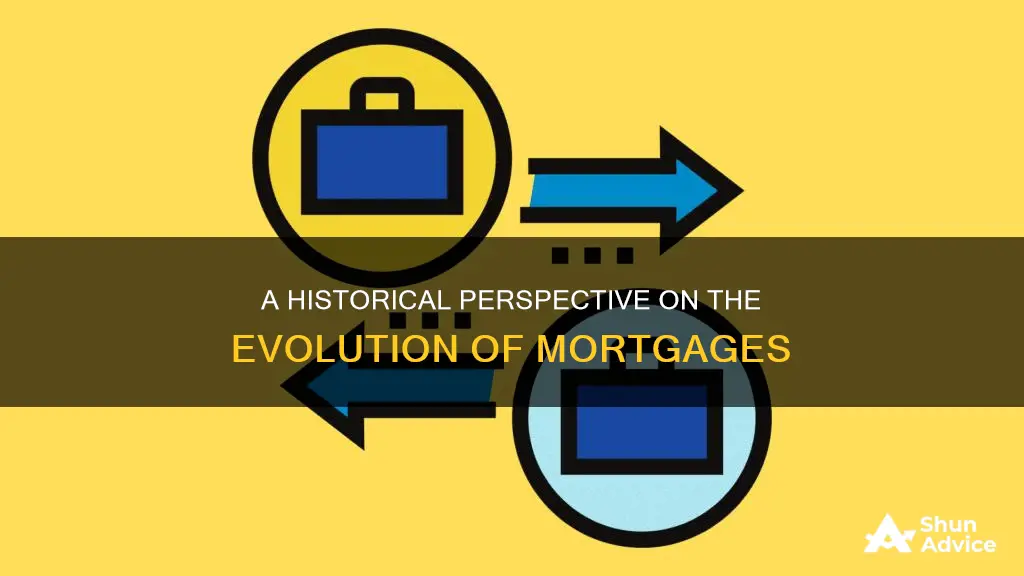
The modern mortgage is the result of a long and complicated history. The concept of a mortgage can be traced back to ancient civilisations, with the term translating to death pledge in Latin. The idea of exchanging property with a pledge to repay over time has been around for centuries and was adopted by the Greeks and Romans from Judaic sources. The modern mortgage, however, only came about in the 1930s, with the founding of the first commercial bank in 1781 and the subsequent expansion of lending institutions in the 19th century, setting the stage for the rapid growth of the US mortgage market in the 20th century. The Great Depression, World War II, and the 2008 financial crisis have all played a significant role in shaping the mortgage landscape, with the government intervening to stabilise the market and protect consumers. Today, mortgages have evolved to meet the needs of modern homebuyers, with stricter regulations and a wider range of loan options.
| Characteristics | Values |
|---|---|
| Date of origin | The concept of a mortgage dates back to ancient civilizations, with the term "mortgage" translating to "death pledge" |
| Modern mortgages | Only around since the 1930s |
| Ancient civilizations | The Romans adopted the concept of debt security, where the creditor held possession of the property while the debtor remained in control until the debt was repaid |
| 1820-1860 | An increase in the number of banks led to a rise in the volume of loans |
| 1864 | The National Bank Act established national bank charters, creating greater security for the federal treasury and a nationalized currency |
| 1893 | Small state banks started to issue bonds based on the credit and trust of the debtor |
| 1920s | Affordable, interest-only mortgage payments became popular, but many borrowers defaulted as they bought homes they couldn't afford |
| 1929 | The stock market crash and the Great Depression changed mortgages, with many borrowers unable to make payments or resell their property |
| 1930s | The Federal Housing Administration (FHA) was created to protect homebuyers and lenders, providing mortgage insurance |
| 1938 | Congress created the Federal National Mortgage Association (Fannie Mae) to purchase loans from lenders and trade them to investors, increasing liquidity |
| Post-WWII | A new generation was ready to settle down, and the GI Bill provided low-interest loans for veterans, increasing homeownership |
| 1949-2000 | The US mortgage market experienced rapid growth, with the debt-to-income ratio rising from 20% to 73% |
| 1980s | Adjustable-rate mortgages (ARMs) were introduced, allowing borrowers to benefit from interest rate fluctuations |
| 2007-2009 | The Great Recession caused by subprime lending and the housing bubble bursting led to stricter lending practices |
| Post-2008 | A shift from a buyer's market to a seller's market, with higher demand and less supply |
| Post-2008 | Banks became less willing to lend to high-risk borrowers and no-money-down mortgages became less common |
| COVID-19 pandemic | Forbearance programs allowed borrowers to pause payments without facing foreclosure due to economic disruptions |
What You'll Learn

The Great Depression and the housing bubble burst
The Great Depression, which began with the stock market crash of 1929, had a profound impact on the mortgage landscape. Before the Depression, homeowners renegotiated their mortgages annually. However, as the economic crisis unfolded, about 1 in 10 homes faced foreclosure, leaving borrowers struggling to resell or facing repossession. This situation was exacerbated by the fact that many borrowers were unable to keep up with their mortgage payments, and the plummeting home values made it difficult to resell properties. As a result, millions of Americans were at risk of foreclosure in the 1930s, and banks also found themselves in a bind as limited funds often made foreclosure unfeasible.
The US government played a pivotal role in responding to this crisis by establishing institutions that backed mortgages. These included the Home Owners' Loan Corporation, the Federal Housing Administration, the Federal National Mortgage Association, and the FDIC. Additionally, the creation of Fannie Mae, a subsect of the National Housing Act, aimed to increase liquidity and free up cash for lenders by purchasing FHA-backed mortgages. These interventions marked a significant shift in the mortgage process, as they introduced fixed-rate loan terms and stabilised the market.
The Great Depression also highlighted the need for fairer lending practices. Up until that point, mortgage lending was often discriminatory and segregated against borrowers of colour. The post-World War II era brought about significant changes, with the introduction of low-interest VA loans for veterans, resulting in an 8% increase in homeownership between 1940 and 1960.
In more recent times, the United States experienced another significant housing bubble burst in 2006, which triggered the Great Recession. This crisis was characterised by a convergence of factors, including risky mortgage lending, inadequate regulation, and the widespread offering of "subprime" mortgages to individuals with low creditworthiness. As a result, homeowners began to default on their mortgage payments in large numbers, leading to a wave of loan losses and exposing other risky loans and overinflated asset prices. This, in turn, sparked a panic in the inter-bank loan market, with many banks suffering substantial losses or even facing bankruptcy.
The 2008 stock market crash and the subsequent Great Recession prompted the largest financial reforms since the Great Depression. These included the Dodd-Frank Act and the establishment of the Consumer Financial Protection Bureau to curb predatory lending. Additionally, stricter regulatory practices were implemented, such as higher minimum credit score requirements and lower maximum debt-to-income ratios for borrowers.
SunTrust Mortgage: Navigating Foreclosure and Your Options
You may want to see also

Post-WWII economic changes
The post-World War II economic changes in the US were marked by a booming economy, with soldiers returning home ready to settle down, start families, and buy homes. This led to a surge in demand in the housing and mortgage markets, and the US government took several measures to support this demand and ensure economic stability.
One significant initiative was the establishment of the Veterans Administration (VA), which created a mortgage insurance system. The VA protected lenders against borrower default and insured mortgage loans made by private lenders to veterans, allowing them to purchase homes at affordable rates without a down payment. This initiative was extremely popular and further boosted the economy.
Additionally, the Federal Housing Administration (FHA), created in 1934, played a crucial role in shaping the modern American mortgage system. The FHA introduced the 30-year mortgage, reduced the down payment required, and developed an appraisal system to assess the risk of properties. These changes made homeownership more accessible and affordable for Americans, with homeownership rates skyrocketing from 44% to 62% between 1940 and 1960.
The post-WWII era also witnessed the emergence of government-sponsored enterprises such as Fannie Mae (Federal National Mortgage Association) and Freddie Mac (Federal Home Loan Mortgage Corporation). These organizations created a secondary mortgage market by insuring mortgages and selling them as securities, attracting global investors to invest in the US economy.
The 1970s and 1980s brought another set of challenges, with interest rates soaring to over 20%. This led to the introduction of adjustable-rate mortgages (ARMs) in the 1980s, which allowed borrowers to benefit from interest rate fluctuations. While this provided flexibility, it also introduced the risk of paying higher interest if rates increased.
Overall, the post-WWII economic changes in the US were characterized by a thriving housing market, supported by government initiatives and regulatory frameworks that made homeownership more accessible to returning soldiers and the general population. These changes laid the foundation for the modern American mortgage system, which continues to evolve to meet the needs of homebuyers.
When is the Right Time to Prequalify for a Mortgage?
You may want to see also

The rise of the US mortgage market
The US mortgage market has evolved significantly since the 1930s, when home mortgages were first introduced. The Great Depression of the 1930s had a profound impact on the mortgage industry, with many lenders failing and delinquencies rising to 50%. The economic crisis made it difficult for homeowners to afford their lump-sum loan payments, leading to a wave of foreclosures.
In response to the crisis, President Franklin D. Roosevelt proposed several changes to the housing market as part of his New Deal program. The Home Owners' Loan Act of 1934 provided emergency relief for mortgage debt and introduced the concept of mortgage refinancing, with longer loan terms and lower interest rates. The Federal Housing Administration (FHA) was also established to improve housing standards and provide access to affordable financing, with lower down payment requirements and longer loan terms. These changes made homeownership more accessible and affordable for Americans.
The post-World War II era witnessed a further expansion of the US mortgage market, with the federal government actively promoting homeownership. The Veterans Administration (VA) was formed to assist returning soldiers in acquiring homes at affordable prices, with favourable loan terms and interest rates. The 1944 Servicemen's Readjustment Act, which included a veterans' home loan program, also contributed to the rise in homeownership during this period.
The US mortgage market continued to evolve in the latter half of the 20th century, with the introduction of adjustable-rate mortgages (ARMs) in the 1980s. This period saw a wave of financial deregulation, with the Depository Institutions Deregulation and Monetary Control Act (DIDMCA) of 1980 and the Garn-St. Germain Depository Institutions Act of 1982 allowing banks to offer adjustable-rate mortgages. These changes aimed to increase competition and provide borrowers with more options.
The US mortgage market has not been without its challenges, including the 2008 housing crisis and the Great Recession, which made it harder for aspiring homeowners to obtain financing. The COVID-19 pandemic also brought unprecedented disruptions, with economic uncertainty leading to significant shifts in the housing and lending markets. However, the US mortgage market has proven to be resilient, adapting to economic, political, and social changes while remaining a cornerstone of the American economy.
When to Apply for a Pre-Approval Mortgage
You may want to see also

The 2008 housing crisis and the Great Recession
The 2008 housing crisis and subsequent Great Recession were the result of a convergence of multiple factors, including a housing bubble, risky mortgage lending, complex financial products, and inadequate regulation. The crisis led to far-reaching changes in the mortgage landscape, with stricter regulatory practices being implemented to prevent predatory lending.
In the years leading up to 2008, the housing market was experiencing a bubble, with home prices and housing credit expanding. This was fuelled by years of ultra-low interest rates and an increased availability of mortgages. Financial institutions offered "subprime" mortgages to people with low creditworthiness and little or no income verification. These adjustable-rate mortgages (ARMs) initially offered low-interest rates but became unmanageable for many borrowers when interest rates rose. As a result, the housing bubble burst, causing a wave of loan defaults and triggering the financial crisis.
The impact of the 2008 financial crisis was severe and far-reaching. It resulted in a loss of over $16 trillion in net worth for US households, a 50% drop in the value of the stock market, and an unemployment rate that peaked at 10% in October 2009. The human toll was significant, with nearly 10 million families losing their homes to foreclosure and many workers struggling to recover their earning potential. The crisis also had a global impact, sparking the Great Recession and contributing to the European debt crisis.
In response to the crisis, governments and central banks, including the Federal Reserve, the European Central Bank, and the Bank of England, provided unprecedented bailouts and stimulus packages to stabilize the economy and encourage lending. The US government passed the Dodd-Frank Wall Street Reform and Consumer Protection Act in 2010, introducing sweeping changes to financial regulation and creating the Consumer Financial Protection Bureau to prevent predatory lending.
The 2008 financial crisis and the Great Recession highlighted the need for stricter regulatory practices and greater protection for consumers in the mortgage market. The crisis also revealed the complex interplay between the housing market, financial institutions, and the broader economy, leading to a fundamental shift in how banks operate, how homes are bought and sold, and how governments regulate the financial industry.
The True Cost of a Mortgage
You may want to see also

The impact of the COVID-19 pandemic
The COVID-19 pandemic has had a profound and ongoing impact on the mortgage industry, significantly altering the landscape for both lenders and borrowers. With the pandemic bringing the global economy to a standstill, the Federal Reserve and mortgage rates dropped to encourage spending. This led to a surge in home loan and refinance applications, creating a highly competitive seller's market with increased demand and a shortage of housing inventory.
The pandemic also exacerbated the existing liquidity crisis in the mortgage industry. Investors stopped purchasing Mortgage-Backed Securities (MBS), limiting the cash available for loans to consumers. This resulted in tighter underwriting guidelines, with higher minimum credit scores, increased down payment requirements, and stricter income standards. Borrowers faced challenges in meeting the changing standards, and the risk of foreclosure loomed for many.
Additionally, the pandemic highlighted the critical importance of a healthy credit score. Lenders became more cautious, and borrowers had to meet higher standards to qualify for loans. The job losses and economic uncertainty meant that proving steady income was essential. While regulations became stricter, the low mortgage rates presented opportunities for those seeking to refinance their loans.
The COVID-19 pandemic also accelerated digital transformation in the mortgage industry. With social distancing and lockdown measures in place, the industry adopted innovative solutions, such as On Q Financial's E-Close format, enabling remote home-buying transactions. These changes aimed to address the challenges of the pandemic and ensure the continuity of the industry.
Overall, the COVID-19 pandemic disrupted the mortgage industry, creating a competitive market, tightening lending standards, and driving digital innovations. The impact of the pandemic continues to shape the industry, and it remains to be seen what long-term effects will persist in the post-pandemic era.
Navy Federal: Your Mortgage Journey Companion
You may want to see also
Frequently asked questions
The term 'mortgage' is derived from two Latin words: 'mort', which means death, and 'gage', which means pledge. The term refers to the idea that the pledge ends once the loan is repaid, and that the property is forfeited if the loan isn't repaid.
The concept of a mortgage began in ancient civilizations, with the earliest references found in Talmudic scriptures. The Romans adopted the concept of debt security by allowing debtors to retain control of property pledged to creditors until the debt was repaid. The modern mortgage, however, is a more recent development, emerging in the 1930s in the United States.
Mortgages have evolved significantly over the years. In the early 1900s, homebuyers often needed a 50% down payment and had to repay the loan within 5 years. The Great Depression of the 1930s led to government intervention and the creation of institutions like the Federal Housing Administration (FHA) to protect homebuyers and lenders. Post-World War II, low-interest VA loans and the GI Bill further boosted homeownership. The late 20th century saw the introduction of adjustable-rate mortgages (ARMs). Stricter regulatory practices were implemented after the 2008 housing crisis. Today, there are more specialized loans tailored to borrowers' needs.
The 2008 housing crisis, part of the Great Recession of 2007-2009, significantly impacted the mortgage market. High home prices, subprime lending, and predatory lending practices contributed to this crisis. In response, banks became more cautious, and smaller mortgage companies filled the gap, leading to increased competition. The COVID-19 pandemic also brought changes, with government forbearance programs helping homeowners pause payments without facing foreclosure.
The role of the government in the mortgage market has evolved significantly. Prior to the 1930s, the government was not directly involved, and private options dominated the market. However, the Great Depression prompted government intervention to protect both homebuyers and lenders. The creation of government institutions like the Home Owners Loan Corporation and the Federal Housing Administration stabilized the market. Over time, the government has sought to increase homeownership through various initiatives, such as the GI Bill and low-interest VA loans for veterans.







